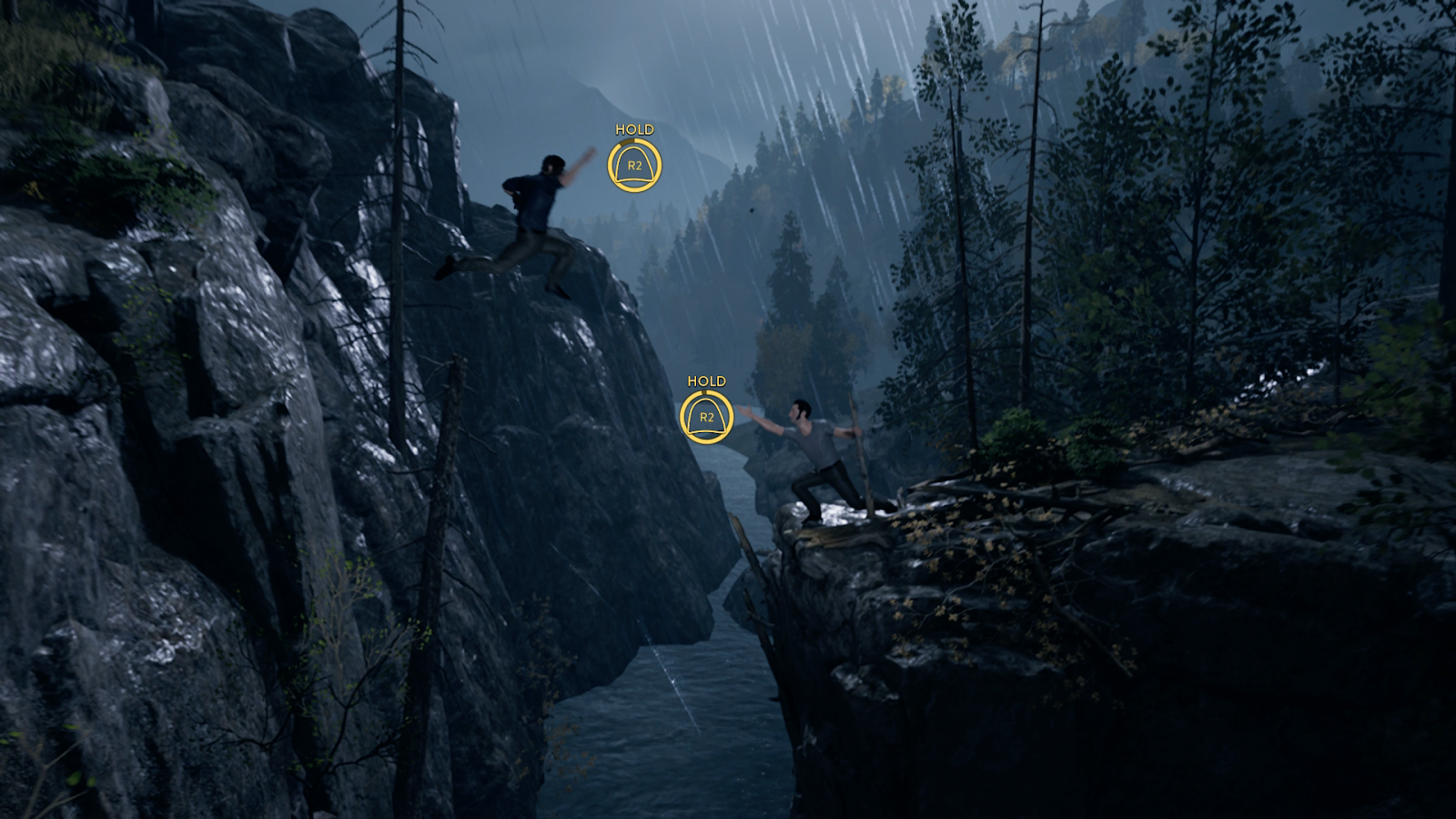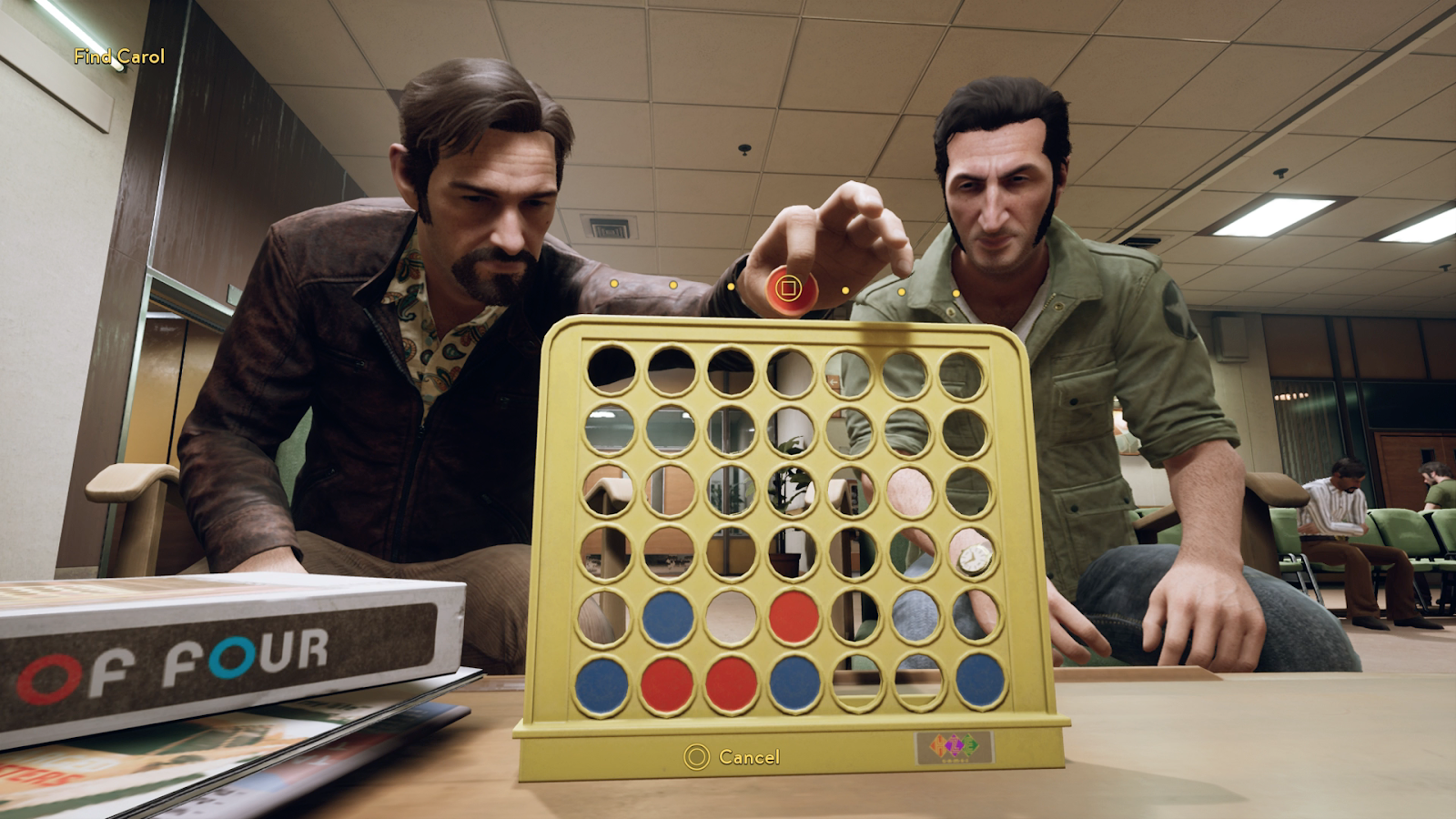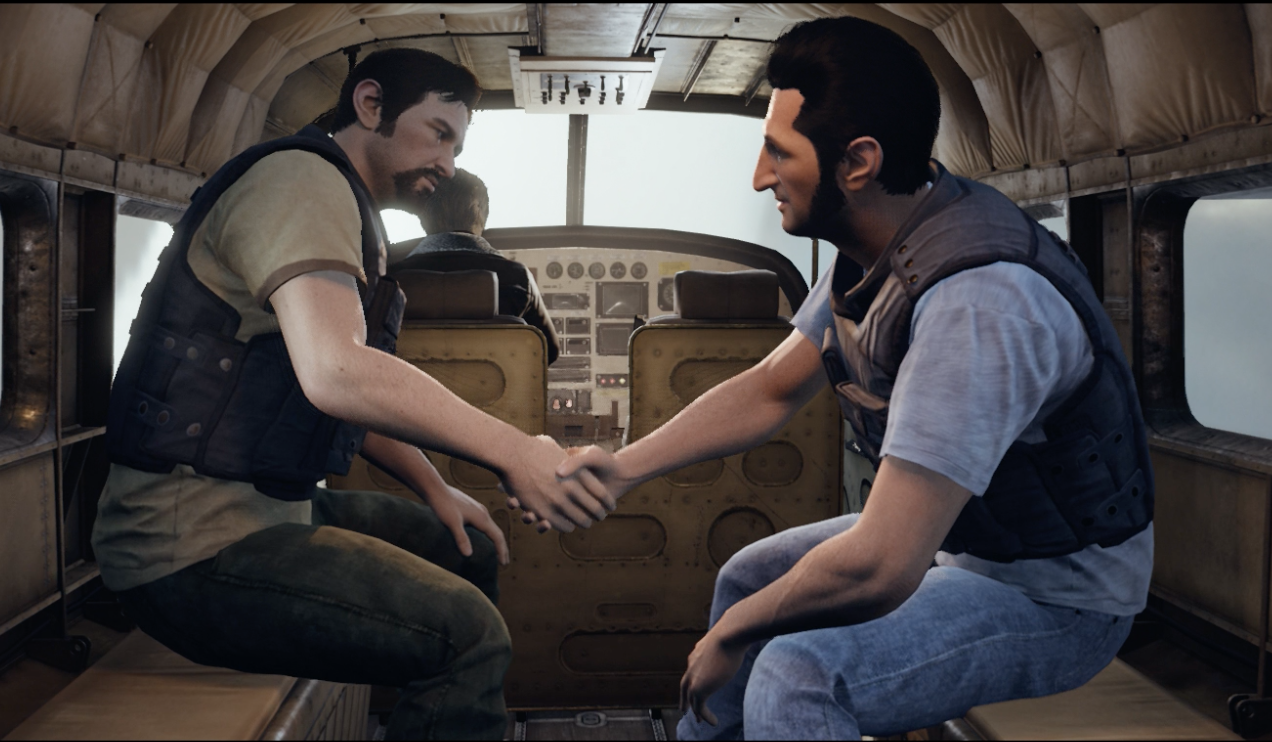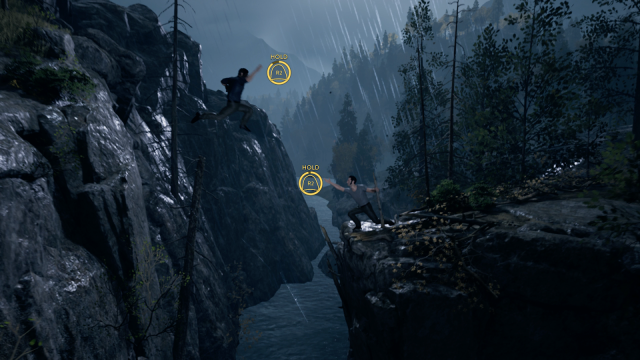A Way Out merges narrative games with couch co-op, and the result is a smart and emotional experience so good that it had to be reviewed by two Kotaku writers. We’ve never played a cooperative experience like it.
The game cannot be played alone. It takes two players to guide a pair of convicts, a smooth talker named Vincent and a headstrong brawler named Leo, as they progress through a series of interconnected scenes of their prison break and the manhunt that follows.
Each player controls one of the characters for the duration of the game and helps the other to survive increasingly harrowing events. Often, this means given the players free rein to roam a small environment full of characters to converse with and small activities to perform.
The player controlling Vincent might wander around the prison yard and exercise while the player controlling Leo gets into a fist fight. When the players converge, the pair both fight off Leo’s attackers. When lives aren’t on the line, Vincent’s player might be in a cutscene while Leo’s player tosses cards into a hat outside of the room.
[review image=”https://i.kinja-img.com/gawker-media/image/upload/brsiox3hzzzbxmjb6snk.png” heading=”A Way Out” label1=”BACK OF THE BOX QUOTE” description1=””Just Guys Bein’ Dudes..”” label2=”DEVELOPER” description2=”Hazelight Studios” label3=”TYPE OF GAME” description3=”Choose Our Own Adventure” label4=”PLATFORMS” description4=”PS4 (played), PC, Xbox One” label5=”LIKED” description5=”Refreshing take of cooperative play, the main characters are fun, great camerawork, the last third of the game is breathtaking.” label6=”DISLIKED” description6=”Dialogue can be stiff, fillers scenes don’t add much and drag down the pace.” label7=”RELEASE DATE” description7=”Now” label8=”PLAYED” description8=”Finished in roughly five hours. Had a grand old time.”]
You can play A Way Out online, but we went through it in person. We played the game on a surprisingly temperate Saturday afternoon at Gita’s apartment. We ordered sushi and cracked open some ciders, planning on making a day of it.
Sitting on the edges of her huge white sectional, we grabbed our controllers tentatively, not sure what to expect. Soon enough, as we both settled into the mindset of the characters we controlled, we played for three hours straight without pausing, our sushi half-eaten.
Gita’s roommates drifted in and out of the living room, observing, before they too were engrossed in the story and watched until the end.
At any given moment, A Way Out shifts to provide new experiences, from river-rafting and basketball to wild car chases. Each new activity retains a simple control scheme that starts to build a language that the player understands. Chief among these is the prompt for cooperative action, like pushing a car or catching someone when the jump. To do those things, both players hold R2 on their controllers.
There is growing familiarity that unfolds as the game progresses, a chance to not only embody your character but trust that your partner is equally competent and trustworthy. As Leo and Vincent grow closer as characters, players come to rely on each other more and more.
To play A Way Out is to build a bond with your partner that carries between each new activity. No matter what the goal – mundane or crucial – that bond holds firm thanks to the game’s simple control scheme. Players will always have each other’s back.

It helps that A Way Out is just as invested in its characters as its mechanics. It would have been easy for the game to maintain a momentum that didn’t allow for much personal development but a lot of time is spent giving Leo and Vincent a chance to feel like real people.
The dialogue is sometimes stiff and the voice acting doesn’t always hold up, but a range of action-packed events and quieter moments give the lead characters depth. We learn that Leo is afraid of heights. We see him visit his family, fix a motorcycle and build a treehouse. Even while on the run, Vincent finds time to sneak into a hospital after the birth of his daughter. These moments don’t last long and trouble usually follows on their heels, but the extra care spent on the protagonists means that each new scene is a delight to play. A Way Out struggles with the rest of its cast but Vincent and Leo shine through.
A Way Out is a marvel in its presentation. It feels like it has been filmed with a camera that has physicality and heft. Cut scenes are staged deliberately, hewing closely to established rules of cinematic presentation. There has rarely, if ever, been a 3D game whose creators cared this deeply about the “180 rule,” the idea that cameras shouldn’t cross an invisible 180 degree line through the scene so that the audience can follow the action.
It’s not enough to say that A Way Out looks like a movie. Many games have action set pieces and emotive cutscenes. Many games strive to be “cinematic.” This is a game that is deeply inspired by specific pieces of media, like The Shawshank Redemption, the work of Martin Scorsese, Heat and even Scarface, but also understands that cameras in video games can do things cameras in movies cannot.
You don’t have to set up a crane or have your actors walk back to their marks. You can transition straight from a foot chase, to a close up, to a slow motion wide shot across a valley at night, and not only will it not feel gratuitous, it’s breathtaking to watch.
The beats of the game’s plot are usually easy to predict. In A Way Out, that is more strength than weakness. It’s much easier to absorb the story and empathise with the characters when your head isn’t spinning from twists.
It’s just a story of two desperate men trying to get home – the basis for many classic narratives.

Sometimes A Way Out feels like you are writing the script of the 70s crime thriller you’re playing, as you are playing it. The choices you make feel like the game’s canon, even if you’re just sitting around playing the banjo for a few minutes while your partner figures out how to progress to the next scene.
A lot of the game is immutable, although most levels give you several options to complete them. Early on, Vincent and Leo need to steal sheets as part of their plan to escape prison. In order to make it past one of the guards, you have to distract him. It’s up to the player to either instigate a fight between two inmates, or to sabotage a laundry machine. Sometimes the game will ask the players to choose a course of action before the level begins – Vincent’s way or Leo’s way.
You first see this when you happen across a cabin. Both characters think it’d be a good place to change clothes, and hopefully steal a car. Unfortunately, there’s a couple inside. Vincent wants to release the horses from the barn so they can distract the couple in a nearby house and steal their car.
Leo wants to just tie the couple up, steal their shit and bounce. Everything the players do is in service of building out Vincent and Leo as characters. Even though their methods differ, you ultimately see two men who are trying their best and who need to rely on each other.
You might not identify directly with the player you’re controlling over the other, but it’s hard not to gel into acting like a team as you play A Way Out. Almost everything you do in this game requires you to communicate with the other player.
Whether it’s jumpstarting a car, keeping an eye out for prison guards, or shimmying up a vent: You cannot go it alone.
The game is special from the start. If you’re reading this review to know if it’s worth playing, you’ve read enough. It is. A full play-through of the game elevates A Way Out further, and to get into that requires major spoilers…

A Way Out pulls its greatest trick during the finale. In a climactic scene, it is revealed that Vincent is not merely a convict on the run but an FBI agent on an undercover operation to learn where one of Leo’s business associates – who also killed Vincent’s brother – hid a stolen diamond.
This sounds like a silly twist befitting a budget action movie but after numerous hours of harrowing co-op gameplay with a friend, it’s a kick to the stomach. In that moment, the game changes from a cooperative experience to something competitive, culminating in one of the most intelligent gameplay shifts in recent memory: an extended gunfight in an abandoned factory that plays like a multiplayer match from any one of today’s online shooters.
The ending changes depending on who wins.
I, Gita, played Leo, and as soon as the screen changed, health bars appearing where there once had been none, I knew I was dead in the water. I don’t really play shooters. Heather reviews them for our site. Still, having embodied Leo this whole game, I was invested in bringing him home to his wife, Linda, and son, Alex. It was a desperate scramble, punctuated by Heather apologizing, and me screaming, “I cannot believe Vincent is a fucking cop.”
But she wore me down, bit by bit. By the time the two characters were crawling across a rooftop in the rain for a gun, I was on my last sliver of health. There were tears in my eyes. I’d spent all of A Way Out kind of knowing only one of them would make it out alive. The game found my one weakness.
I had hoped by the end they’d still be able to look each other in the eye. I still can’t believe A Way Out made me live through that. I can’t believe I had to watch Leo die after how long he’d strived to be a free man.
I, Heather, played Vincent, and was placed into one of the toughest situations I’ve ever endured in a game. As Gita scrambled from cover to cover, I positioned myself firmly on the high ground and fired in bursts. Bit by bit, I wore down her health bar and in doing so, punched bullet holes into Leo that left him sputtering blood.
Narratively, I had a duty to see Vincent’s motivations through to the very end. He had a daughter to go home to and job to perform. But fulfilling that motivation meant beating one of my best friends in a sudden and unfair gunfight where I had years of experience that she did not.
I apologised with each shot, hastily trying to explain that I simply couldn’t stop now. I had to see this through even if that meant leaving my friend beaten and bloodied.

After a rooftop firefight, the pair of us scrambled to pick up a nearby gun. Because Gita was already wounded, I got there first and painfully pulled the trigger. Leo fell back, on the edge of death, and we received one more button prompt. It was the prompt we’d used so many times before.
We both held R2 and watched as Vincent held Leo’s hand until he died. The split-screen ended and only Vincent was left to take up the screen. A Way Out had taken us from prison break to Connect Four and finally to a bleak and horribly avoidable death. The game’s creators had delivered something we weren’t prepared for and which left us speechless.
A Way Out is a simple story told very, very well. Its levels run the gamut from car chases to robberies to a full on assault on a drug lord’s mansion. Nothing is more affecting and memorable in this game than that simple button prompt.
It is a game full of smart moments, perfect for bringing together dedicated gamers and curious onlookers alike.

Comments